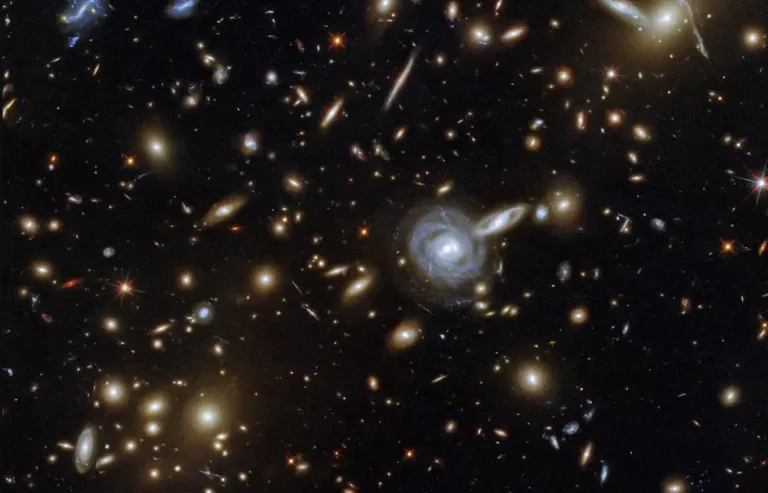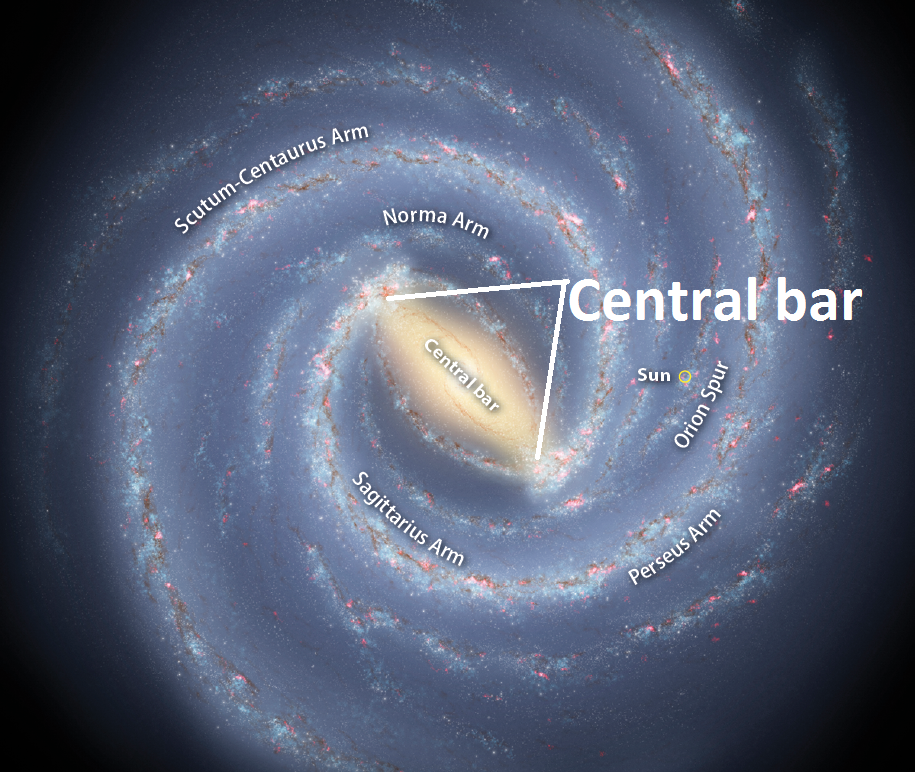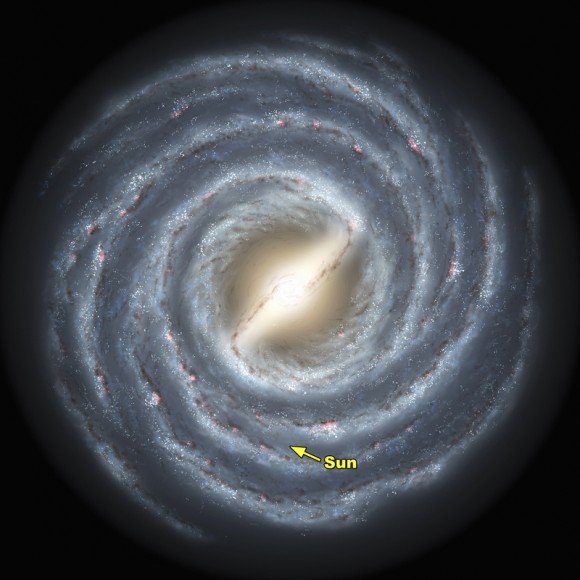The Milky Way Galaxy, Where we live | Cosmology
The word 'galaxy' is derived from the Greek galaxias. A galaxy is a region of the universe bound by the gravitational pull of stars, interstellar and planetary remnants, gas, dust, and matter. A galaxy rotates around its center of mass. Galaxies can be of three types: elliptical, spiral or irregular. At the center of galaxies is a supermassive and massive black hole from which even light cannot escape. A cluster is formed with numerous such galaxies.

Now let's know about the location of Milky Way Galaxy. There are billions of galaxies in our universe or we don't really know how many there are. Because we can see a tiny area of the universe through the world's most powerful telescope. But our galaxy and our local galaxy group can be seen and observed by scientists. The Local Group of galaxies consists of our neighboring galaxies. The Local Group galaxies are located within about 5 million light-years of the Milky Way galaxy where the Milky Way can be thought of as the center. Among the three big galaxies of the local group, Andromeda Galaxy is biggest, our Milky Way is 2nd biggest and the Triangulum Galaxy is 3rd biggest. Now the question is what is our nearest galaxy? The answer is as follows
The closest known galaxy to us is the Canis Major Dwarf Galaxy, at 236,000,000,000,000,000 km (25,000 light years) from the Sun. The Sagittarius Dwarf Elliptical Galaxy is the next closest , at 662,000,000,000,000,000 km (70,000 light years) from the Sun.source
The Local Group galaxies are part of the Virgo supercluster at the edge of which the Local Group is located. The Virgo supercluster is also called its orbit of galaxies. 100 galaxy groups and clusters and our local group located within the Virgo supercluster. The diameter of this supercluster is about 110 million light years.
Our Earth and Solar System are a small part of the Milky Way Galaxy. Since we live in this galaxy, it is our galaxy. The Solar System is located about 27,000 light-years from the center of this galaxy and in the Orion arm of the Milky Way galaxy. At its center is the supermassive black hole, called Sagittarius A*. Several elliptical galaxies associated with the Milky Way and the nearby galaxy Andromeda are also members of this cluster.

Because Earth is part of the Milky Way galaxy, the Milky Way appears as a light white cloud stretching from one end of the clear night sky to the other. You can see this scene in the night sky with the naked eye from an unlit area. Planets and many stars can be seen in the night sky. You'll also see a faint band that stretches from horizon to horizon. This is the Milky Way Galaxy. It may not be as bright to the naked eye as you see in the image above. But you can see the Milky Way Galaxy as in the image but in a smaller size. I have been watching it since childhood. If you want to observe it better, you need a telescope, even a small one
The Milky Way is 100,000 light-years in diameter and about 1,000 light-years thick. There may be some differences of opinion. The galaxy contains at least 200 billion to at most 400 billion stars. The number of stars is estimated because scientists do not have exact calculations. It is second in mass in the local galaxy cluster. Its mass is 1.5 trillion solar masses. The mass of the Milky Way Galaxy is close to that of our nearest large galaxy, Andromeda. Its rotational speed is about 220 km/s. The total mass of all the stars in the Milky Way is 4.6 x 1010 solar masses. You will be surprised to know that 90% of the mass of the Milky Way is dark matter. Dark matter is an unknown and invisible form of matter that interacts with ordinary matter through gravitational force, so its existence is felt.
Determining the age of galaxies is an extremely difficult task. The age of the Milky Way is determined by measuring the amount of beryllium present in the Milky Way's oldest stars. It is believed that hydrogen, helium and lithium were present right after the Big Bang. We know that when heavy elements such as carbon, iron, nickel, gold, etc. are produced inside a star and dispersed through supernovae. Beryllium originally formed in the interstellar medium as cosmic rays induced fission in heavier elements found in the interstellar medium. Because beryllium is formed without supernovae, scientists use it as a "cosmic clock". It is thought that the longer the period between the oldest stars that formed heavy elements and the stars that formed globular clusters in the early Milky Way, the more beryllium was exposed to galactic cosmic rays. Thus the age of the Milky Way can be calculated by measuring the beryllium content of the oldest stars in the Milky Way.
The name of the oldest star in the Milky Way galaxy is HE 1523-0901 which is a bright red giant star. It is about 13.4 billion years old, which is about the age of the universe. However, it is thought that the formation of the Milky Way began about 6.5 to 10.1 billion years ago.

The center of the Milky Way is a barred-looking region made up of gas, dust, and stars. The bar is centered at the center of the galaxy's spiral arms, and has a supermassive black hole at its center, as seen in the image above. Studies have shown that the bar is very long, about 27,000 light-years. Astronomers first suggested a bar structure at the center of the Milky Way in the 1960s, which was supported in 2005 by Spitzer Space Telescope observations.
The inner part of the central region of the Milky Way is relatively denser with a stellar density of up to 100 per cubic parsec. Because of the black hole at the center, the gravitational force is high so the stars are crowded together. Scientists say that this part contains the oldest stars. Located within a radius of about 10,000 light years from the center, this spherical part is called a bulge, which is a tightly packed group of stars within a larger star formation. The central bar structure of the Milky Way has created a pseudo-bulge that is rich in heavy elements. The central region of the Milky Way is a powerful source of radio waves, which scientists have named Sagittarius A*, a supermassive black hole. By considering the motion of objects near the central region such as stars, planets, etc., scientists have predicted that the center of the galaxy has a massive object which is a black hole. The black hole has a mass of 4.1 to 4.5 million solar masses.
The length of the central bar region of the Milky Way is about 27,000 light-years long. It is at an angle of 10-50 with the earth. The bar is surrounded by a ring called the 5-kpc ring. This is where most of the Milky Way's star-forming activity takes place. Viewed from the Andromeda Galaxy, it can be identified as the brightest part of the Milky Way. The reason this region is so bright is because it contains a large number of star clusters and massive stars.
If you look closely, you will see that the Milky Way Galaxy is a spiral formation. As mentioned earlier, galaxies can be of different shapes. The Milky Way galaxy has a bar at its center called a barred spiral. The Milky Way has four main arms, the Norma and Cygnus arms, Sagittarius, Scutum-Crux, and Perseus. Our Sun or Solar System is located on the Orion Spur, a small arm.
The Orion Arm is a small spiral arm of the Milky Way Galaxy. The Orion Spur arm is 3,500 light-years across and 10,000 light-years long. In this arm is the position of our solar system including the earth. The full name of this arm is the Orion-Cygnus Arm. There are also various names such as Local Arm, Orion Bridge and, earlier, Local Spur and Orion Spur. You surely know about the Orion Nebula and the Orion Belt. This arm is named after them.

The sun and the Solar System is located at a radius of about 27,000 light-years from the Center of our Milky Way galaxy. Our solar system is slowly moving towards the center of the Milky Way Galaxy. Japanese scientists recently say that the solar system is both moving faster and residing closer to our Milky Way galaxy's center where there is a supermassive black hole. As we move towards the center our speed increases.
The Solar System orbits the center of the Milky Way at 140 miles per second.The orbit of the Sun in our Milky Way Galaxy is so long that it takes about 225-250 million years to complete a journey around the galactic center. As the Sun moves further towards the center of the galaxy, its speed will increase. This is because stars far from the center of the galaxy move slower and stars closer to the center move faster. Different parts of the galaxy rotate at different rates around the center hence this is called "differential rotation".There is no doubt that we are in a complex motion. Motion of Sun, Motion of Earth and Motion of Galaxy. Who knows how many other motions there are. Thinking about all these things gives me a headache.
References
1.earthsky
2.wikipedia
3.space
4.education.psu
5.universetoday
6.wikipedia
7.wikipedia
8.wikipedia
9.arxiv
10.abyss.uoregon
11.universetoday
12.earthsky
13.earthsky
14.earthsky
Thanks for reading
Best regards

Thanks for your contribution to the STEMsocial community. Feel free to join us on discord to get to know the rest of us!
Please consider delegating to the @stemsocial account (85% of the curation rewards are returned).
Thanks for including @stemsocial as a beneficiary, which gives you stronger support.
Congratulations @momins! You have completed the following achievement on the Hive blockchain and have been rewarded with new badge(s):
Your next target is to reach 15000 upvotes.
You can view your badges on your board and compare yourself to others in the Ranking
If you no longer want to receive notifications, reply to this comment with the word
STOPCheck out the last post from @hivebuzz:
Support the HiveBuzz project. Vote for our proposal!
Interesting documented information. For an alien my address would be: city Valencia, state Carabobo, country Venezuela, continent America, planet Earth, planetary system Solar, Orion spur between the arm of Perseus and the arm of Sagittarius in the Milky Way galaxy.
Very funny. The way of saying the address was very good. If we find the aliens, I will give them your address. Ha ha...